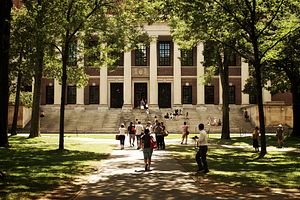Last week, the Biden administration announced that it would ease restrictions on visas by expanding national interest exemptions for foreign students and academics from China, Iran, Brazil, South Africa, the Schengen area, the United Kingdom, and Ireland. Any students with valid F-1 or M-1 visas for programs starting on August 1 will be automatically considered for an exemption to travel and may enter the United States no earlier than 30 days prior to the start of their studies. This move will likely have the most significant impact on Chinese students and scholars as the top source of international students in the United States.
New international student enrollment slipped by 43 percent in the fall and spring semesters of the 2020-2021 academic year, with nearly 40,000 students deferring at U.S. institutions amid the COVID-19 pandemic. In the previous year, Chinese students accounted for around 35 percent of international students in the United States, making up 372,000 of the more than 1 million enrolled for the academic year, according to data from the International Education Exchange.
China has long held the top spot as the place of origin for international students. In the 2019-2020 academic year, it nearly doubled the number of students from India (India ranks second).
The number and share of Chinese students studying in U.S. colleges and universities has been growing steadily. Two decades ago at the start of the 21st century, nearly 60,000 Chinese students came to the United States for their studies, accounting for more than 10 percent of international students.
International students are also an important contribution to the U.S. economy with education services ranking sixth in service exports in 2019. In 2018, international students added $44 billion to the U.S. economy, around $15 billion of which was generated by Chinese students.
Following the news from the Biden administration, the U.S. embassy and consulates in China were slated to reopen on May 4 for visa appointments. Within the first hour of opening the embassy’s website, the embassy in Beijing received more than 3,000 applications, according to acting consul general William Bistransky. The embassy also plans to be able to conduct 3,000 student visa appointments a day by mid-May, as they ramp up operations. Chinese students applying for visas for fall study in the United States must submit their application at least 120 days in advance, and a backlog is likely to build up. (At time of publication, only the U.S. embassy in Beijing listed updated wait times for appointments; the other consulates in Chengdu, Guangzhou, Shanghai, Shenyang, and Wuhan were either temporarily closed or only open for emergency appointments.)
Although Bistransky said the return of visa appointments signals that the United States “welcome[s] foreign students into our homes or communities or universities,” other restrictions imposed in recent years remain. During the Trump administration, the White House put restrictions on Chinese students in STEM fields and barred graduate students and researchers from studying or working in the United States if they had any previous affiliation with China’s People’s Liberation Army, citing espionage and intellectual property theft concerns. Such moves, coupled with harsh rhetoric about the spread of the coronavirus, led to a rise in anti-Asian violence in the United States and bred distrust and marginalization of Chinese nationals on the campuses of U.S. institutions.
There is a real danger in extreme politicization of a nationality, especially in the current climate of China-U.S. relations. Renewing commitment to academic freedom and the promotion of academic exchange should be an evergreen priority. These travel and visa exemptions should be seen as a welcome step in the right direction, but there are still numerous obstacles – both logistic and political in kind. Though there remains sizable demand from Chinese students seeking an education in U.S. institutions, the combination of logistical hurdles and heightened geopolitical antipathy (and at times hostility) between Beijing and Washington is likely to stymie the return of any semblance of promising people-to-people exchanges.

































